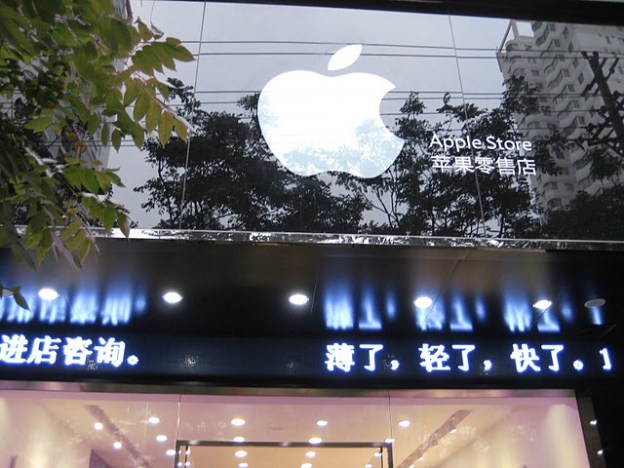
The Chinese aren’t exactly know for their respect for intellectual property rights. Just take a trip to Chinatown in New York City, and you’ll see an endless chain of tiny stores selling knockoff Gucci bags, fake Chanel sunglasses and forged Calvin Klein belts. And we’re all too well aware of the bogus gadgets that too frequently get pawned off as the real thing on gadget blogs. If you actually go to China, however, the scale of counterfeiting apparently grows to an absurd level: They are now opening entirely counterfeit brick-and-mortar Apple Stores. That’s right; the whole store is a fraud.
Evidence of the fake Apple retail locations comes via American ex-pat blogger “BirdAbroad,” who today posted pictures of a number of phony Apple Stores in the city of Kunming, China, which is cloistered away in the country’s southern region — or, as BirdAbroad describes it, “the end of the Earth.”
She explains the bizarre scene:
“We proceeded to place a bet on whether or not this was a genuine Apple store or just the best ripoff we had ever seen – and to be sporting, I bet that it was real.
“I know, you guys are laughing: an Apple store in Kunming? No one who doesn’t know me personally has ever heard of Kunming before. Kunming is the end of the Earth. It’s all true – but seriously, China warps your mind into believing that anything is possible, if you stay here long enough. When we went back to this store 5 days later and couldn’t find it, having overshot by two blocks, I seriously thought that it had simply been torn down and replaced with a bank in the mean time – hey, it’s China. That could happen.
“You have already guessed the punchline, of course: this was a total Apple store ripoff. A beautiful ripoff – a brilliant one – the best ripoff store we had ever seen (and we see them every day). But some things were just not right: the stairs were poorly made. The walls hadn’t been painted properly.”

One of the most astonishing (and saddest) parts of the story is that the fake Apple Store salespeople “all genuinely think they work for Apple,” writes BirdAbroad. “I tried to imagine the training that they went to when they were hired, in which they were pitched some big speech about how they were working for this innovative, global company – when really they’re just filling the pockets of some shyster…”
The blogger says she tried to take pictures of the stores, but was “quickly accosted by two salespeople inside, and three plain clothes security guys outside.” Once she told them that she was an Apple employee from the United States, however, they gladly let her snap a few shots.
Upon leaving, BirdAbroad quickly discovered two more imitation Apple Stores just around the corner, one of which had a sign that read “Apple Stoer.”
Apple does have a small but growing number of legitimate retail operations in China. Those stores, however, are limited to the capital, Beijing, and to the bustling metropolis of Shanghai — far, far away from the nether regions of Kunming.
Read BirdAbroad’s full story here.


